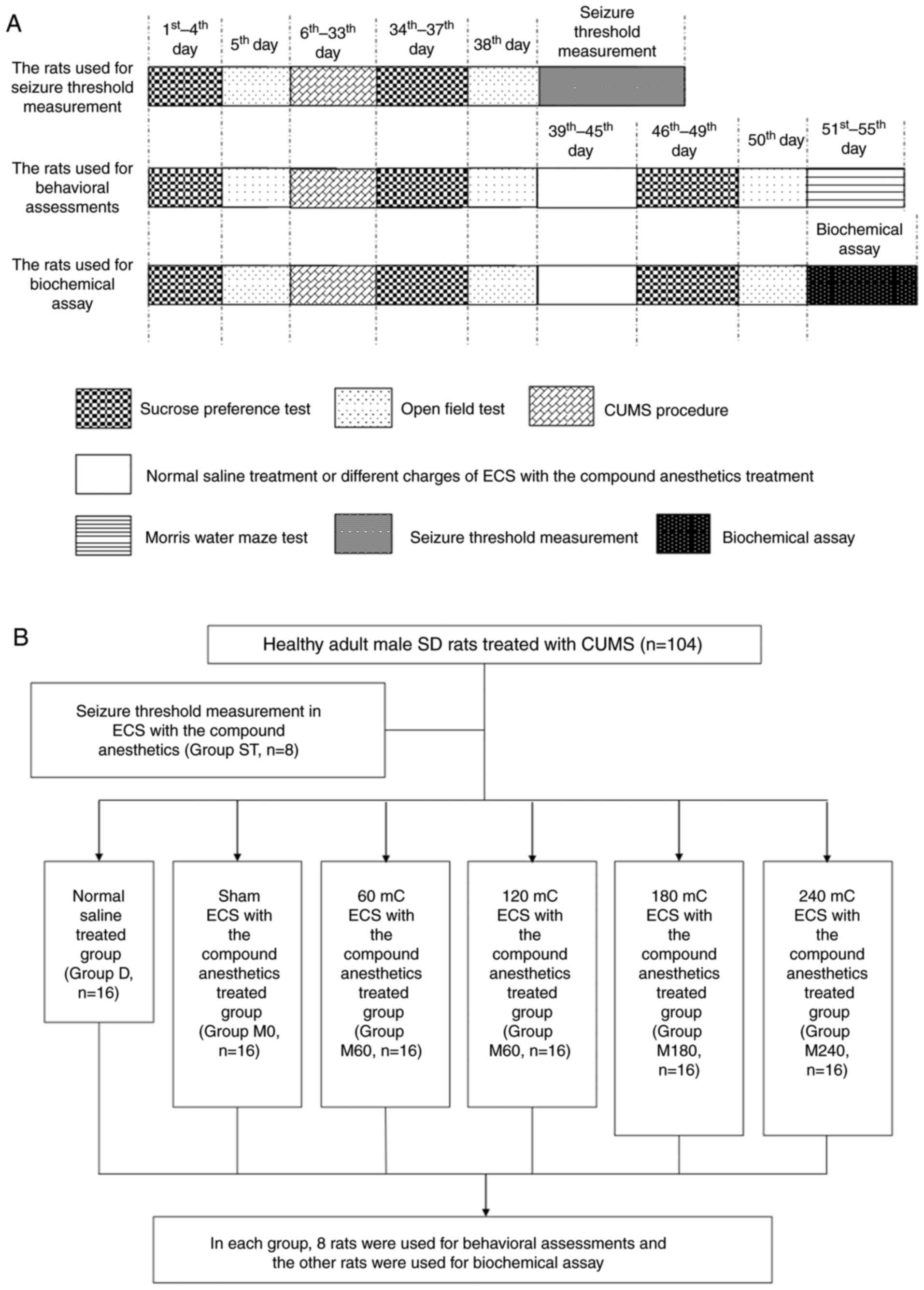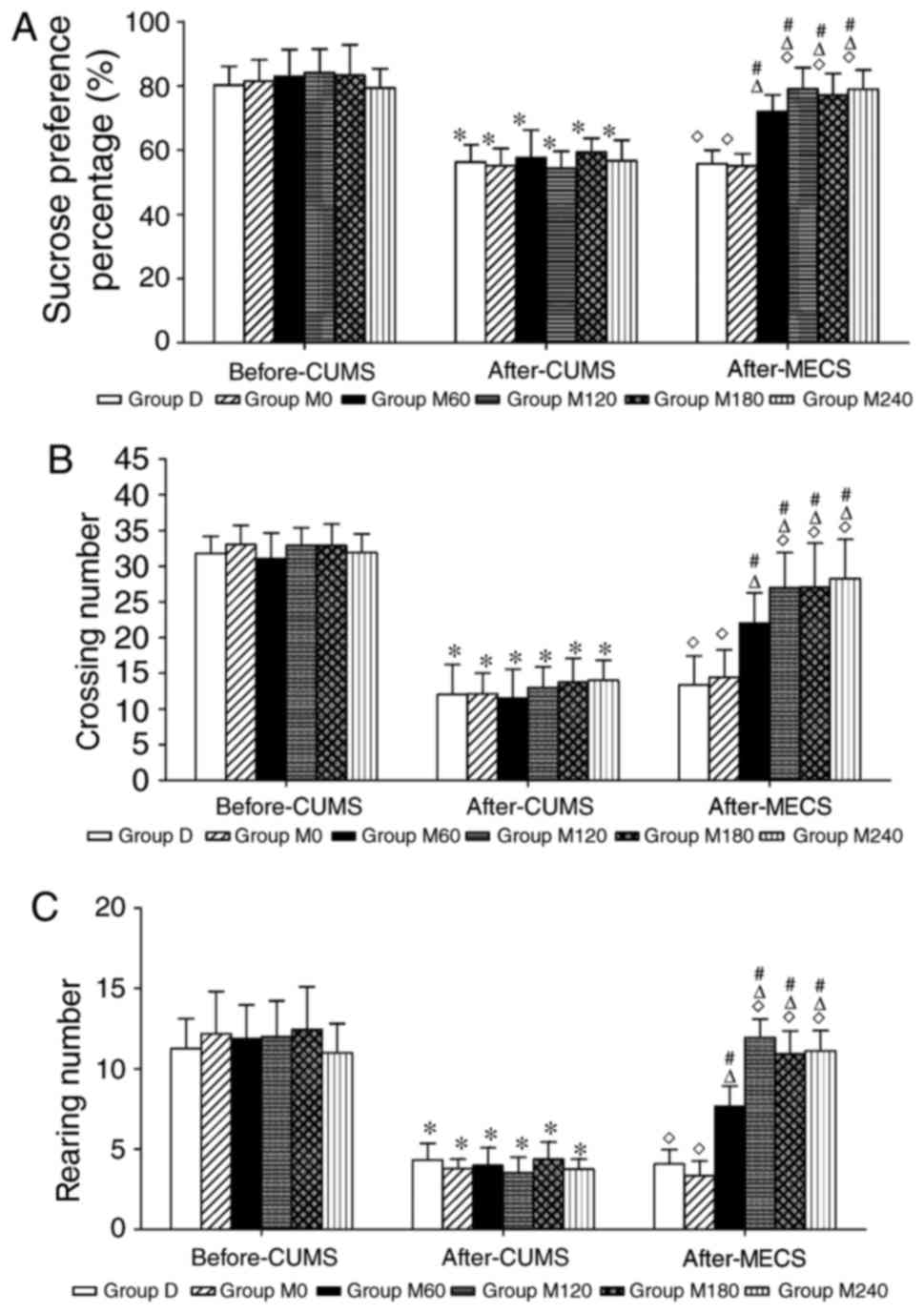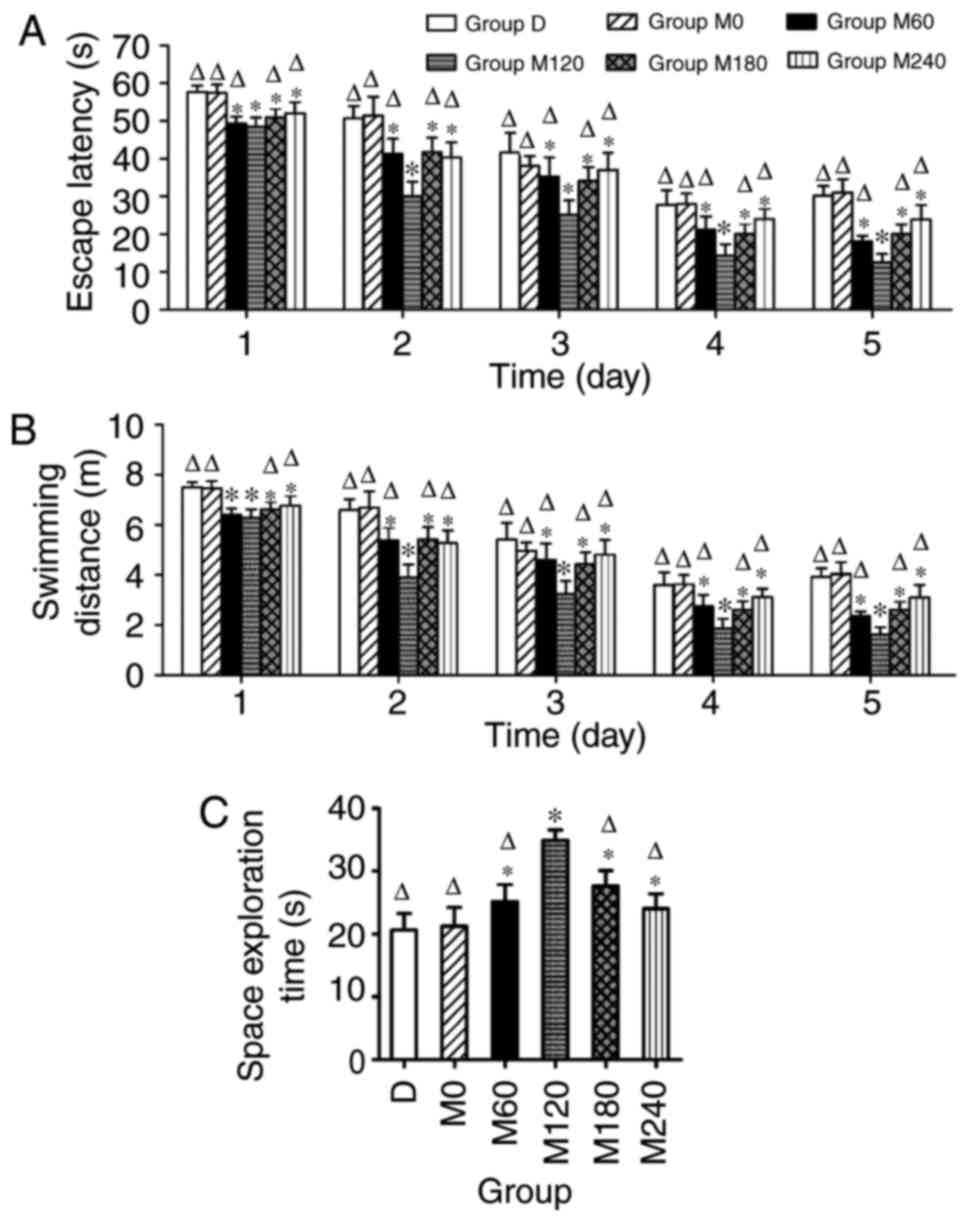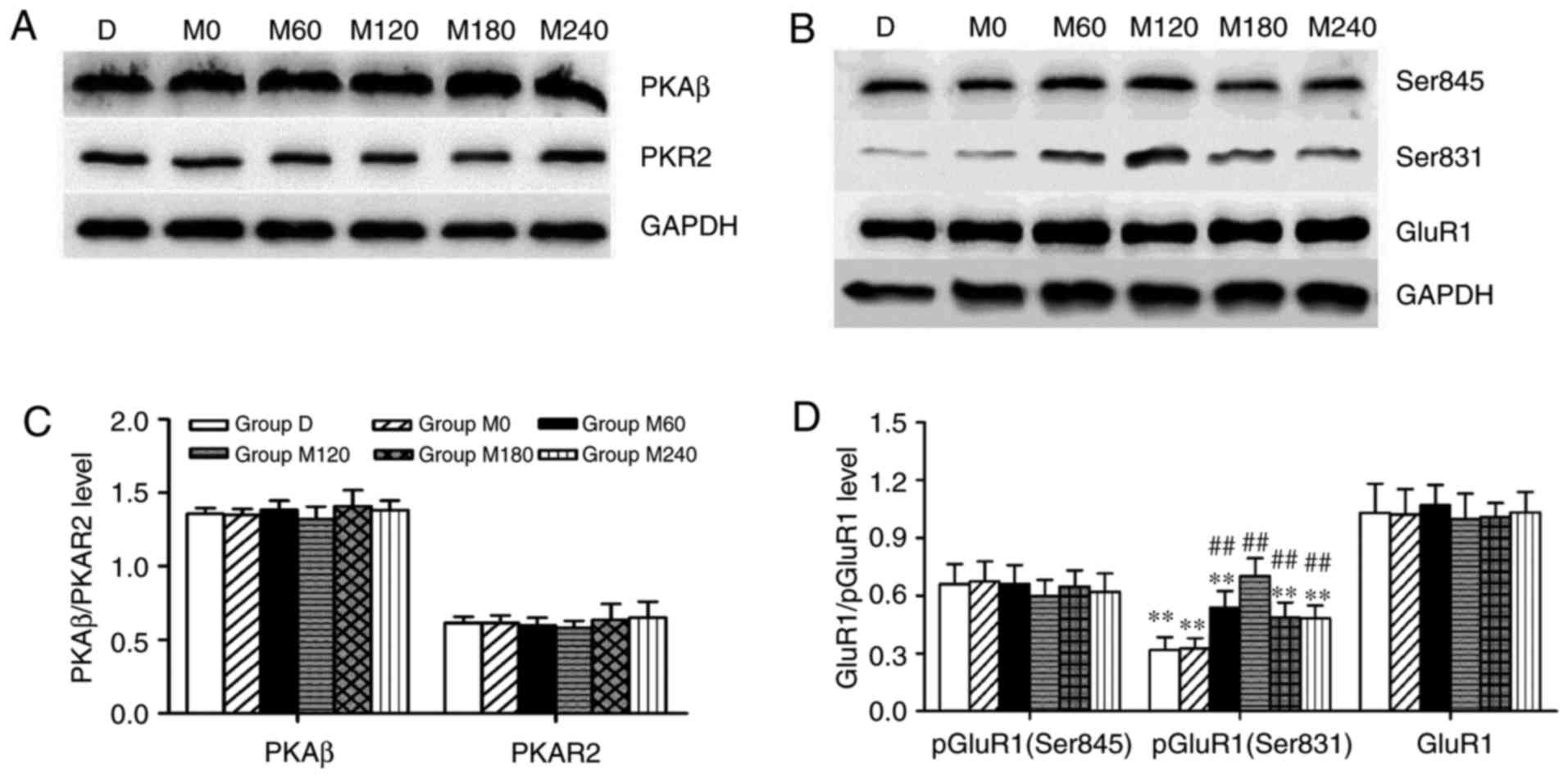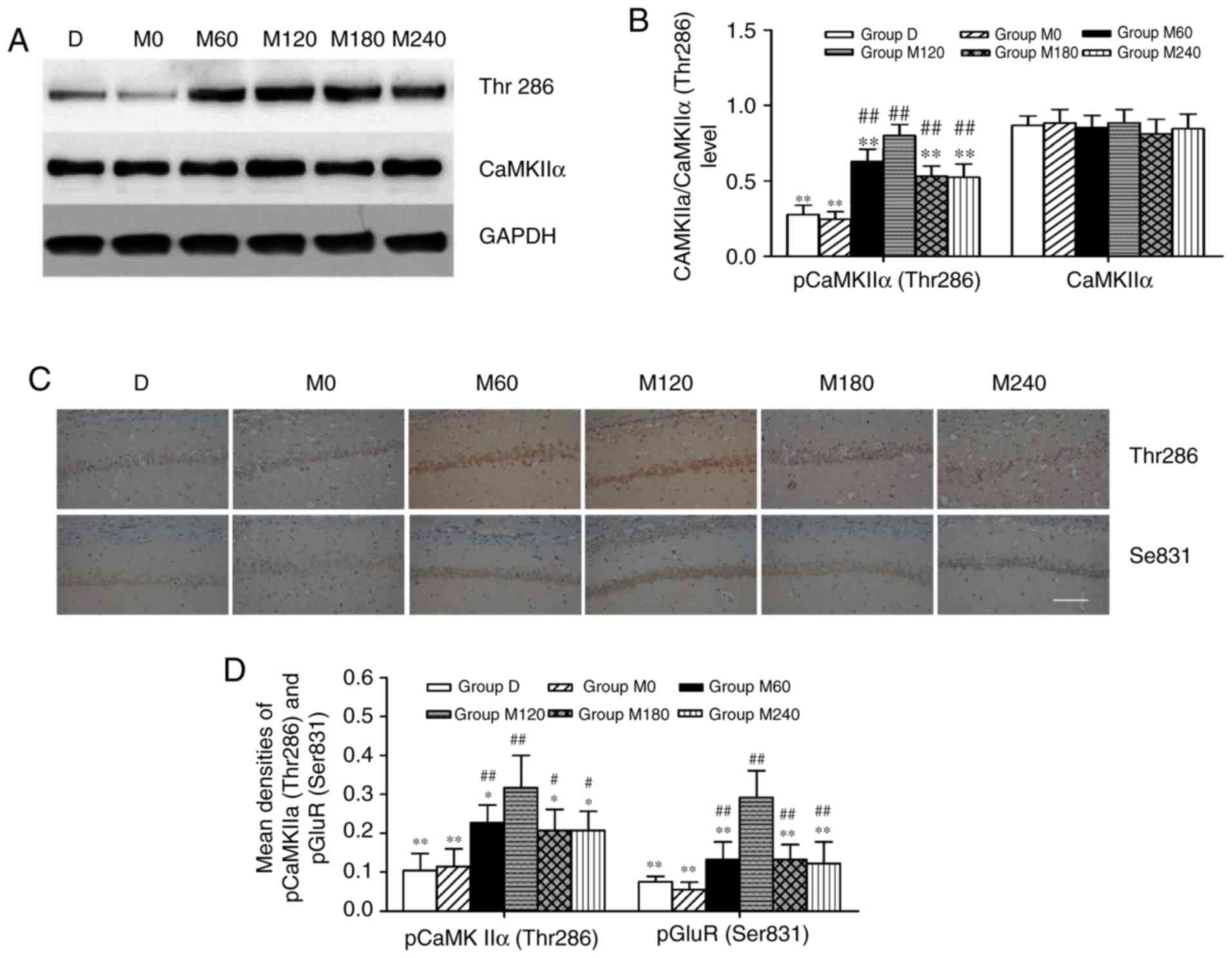|
1
|
Han J, Wang LU, Bian H, Zhou X and Ruan C:
Effects of paroxetine on spatial memory function and protein kinase
C expression in a rat model of depression. Exp Ther Med.
10:1489–1492. 2015. View Article : Google Scholar : PubMed/NCBI
|
|
2
|
Pittenger C and Duman RS: Stress,
depression, and neuroplasticity: A convergence of mechanisms.
Neuropsychopharmacology. 33:88–109. 2008. View Article : Google Scholar : PubMed/NCBI
|
|
3
|
Pagnin D, de Queiroz V, Pini S and Cassano
GB: Efficacy of ECT in depression: A meta-analytic review. J ECT.
20:13–20. 2004. View Article : Google Scholar : PubMed/NCBI
|
|
4
|
Lisanby SH: Electroconvulsive therapy for
depression. N Engl J Med. 357:1939–1945. 2007. View Article : Google Scholar : PubMed/NCBI
|
|
5
|
Patel AS, Gorst-Unsworth C, Venn RM,
Kelley K and Jacob Y: Anesthesia and electroconvulsive therapy: A
retrospective study comparing etomidate and propofol. J ECT.
22:179–183. 2006. View Article : Google Scholar : PubMed/NCBI
|
|
6
|
Luo J, Min S, Wei K, Cao J, Wang B, Li P,
Dong J and Liu Y: Propofol prevents electroconvulsive-shock-induced
memory impairment through regulation of hippocampal synaptic
plasticity in a rat model of depression. Neuropsychiatr Dis Treat.
10:1847–1859. 2014.PubMed/NCBI
|
|
7
|
Zhu X, Hao X, Luo J, Min S, Xie F and
Zhang F: Propofol inhibits inflammatory cytokine-mediated glutamate
uptake dysfunction to alleviate learning/memory impairment in
depressed rats undergoing electroconvulsive shock. Brain Res.
1595:101–109. 2015. View Article : Google Scholar : PubMed/NCBI
|
|
8
|
Rampton A, Griffin R, Durcan J and Stuart
C: Propofol and electroconvulsive therapy. Lancet. 331:296–297.
1988. View Article : Google Scholar
|
|
9
|
Warnell RL, Swartz CM and Thomson A:
Propofol interruption of ECT seizure to reduce side-effects: A
pilot study. Psychiatry Res. 175:184–185. 2010. View Article : Google Scholar : PubMed/NCBI
|
|
10
|
Naughton M, Clarke G, O'Leary OF, Cryan JF
and Dinan TG: A review of ketamine in affective disorders: Current
evidence of clinical efficacy, limitations of use and pre-clinical
evidence on proposed mechanisms of action. J Affect Disord.
156:24–35. 2014. View Article : Google Scholar : PubMed/NCBI
|
|
11
|
White PF, Way WL and Trevor AJ:
Ketamine-its pharmacology and therapeutic uses. Anesthesiology.
56:119–136. 1982. View Article : Google Scholar : PubMed/NCBI
|
|
12
|
Kranaster L, Kammerer-Ciernioch J, Hoyer C
and Sartorius A: Clinically favourable effects of ketamine as an
anaesthetic for electroconvulsive therapy: A retrospective study.
Eur Arch Psychiatry Clin Neurosci. 261:575–582. 2011. View Article : Google Scholar : PubMed/NCBI
|
|
13
|
Okamoto N, Nakai T, Sakamoto K, Nagafusa
Y, Higuchi T and Nishikawa T: Rapid antidepressant effect of
ketamine anesthesia during electroconvulsive therapy of
treatment-resistant depression: Comparing ketamine and propofol
anesthesia. J ECT. 26:223–227. 2010. View Article : Google Scholar : PubMed/NCBI
|
|
14
|
Zarate CA, Singh JB, Carlson PJ, Brutsche
NE, Ameli R, Luckenbaugh DA, Charney DS and Manji HK: A randomized
trial of an N-methyl-D-aspartate antagonist in treatment-resistant
major depression. Arch Gen Psychiatry. 63:856–864. 2006. View Article : Google Scholar : PubMed/NCBI
|
|
15
|
Corlett PR, Honey GD, Aitken MR, Dickinson
A, Shanks DR, Absalom AR, Lee M, Pomarol-Clotet E, Murray GK,
McKenna PJ, et al: Frontal responses during learning predict
vulnerability to the psychotogenic effects of ketamine: Linking
cognition, brain activity and psychosis. Arch Gen Psychiatry.
63:611–621. 2006. View Article : Google Scholar : PubMed/NCBI
|
|
16
|
Bowdle AT, Radant AD, Cowley DS, Kharasch
ED, Strassman RJ and Roy-Byrne PP: Psychedelic effects of ketamine
in healthy volunteers relationship to steady-state plasma
concentrations. J Am Soc Anesthesiologists. 88:82–88. 1998.
|
|
17
|
Chen J, Peng LH, Luo J, Liu L, Lv F, Li P,
Ao L, Hao XC and Min S: Effects of low-dose ketamine combined with
propofol on phosphorylation of AMPA receptor GluR1 subunit and
GABAA receptor in hippocampus of stressed rats receiving
electroconvulsive shock. J ECT. 31:50–56. 2015. View Article : Google Scholar : PubMed/NCBI
|
|
18
|
Andrade C, Kurinji S, Sudha S and Chandra
JS: Effects of pulse amplitude, pulse frequency and stimulus
duration on seizure threshold: A laboratory investigation. J ECT.
18:144–148. 2002. View Article : Google Scholar : PubMed/NCBI
|
|
19
|
Xu Y, Li X, Wang X, Yao J and Zhuang S:
miR-34a deficiency in APP/PS1 mice promotes cognitive function by
increasing synaptic plasticity via AMPA and NMDA receptors.
Neurosci Lett. 670:94–104. 2018. View Article : Google Scholar : PubMed/NCBI
|
|
20
|
Treccani G, Kristian GDJ, Wegener G and
Müller HK: Differential expression of postsynaptic NMDA and AMPA
receptor subunits in the hippocampus and prefrontal cortex of the
flinders sensitive line rat model of depression. Synapse.
70:471–474. 2016. View Article : Google Scholar : PubMed/NCBI
|
|
21
|
Maeng S, Zarate CA Jr, Du J, Schloesser
RJ, McCammon J, Chen G and Manji HK: Cellular mechanisms underlying
the antidepressant effects of ketamine: role of
alpha-amino-3-hydroxy-5-methylisoxazole-4-propionic acid receptors.
Biol Psychiatry. 63:349–352. 2008. View Article : Google Scholar : PubMed/NCBI
|
|
22
|
Greger IH, Ziff EB and Penn AC: Molecular
determinants of AMPA receptor subunit assembly. Trends Neurosci.
30:407–416. 2007. View Article : Google Scholar : PubMed/NCBI
|
|
23
|
Nordgren M, Karlsson T, Svensson M, Koczy
J, Josephson A, Olson L, Tingström A and Brené S: Orchestrated
regulation of Nogo receptors, LOTUS, AMPA receptors and BDNF in an
ECT model suggests opening and closure of a window of synaptic
plasticity. PLoS One. 8:e787782013. View Article : Google Scholar : PubMed/NCBI
|
|
24
|
Keifer J and Zheng Z: AMPA receptor
trafficking and learning. Eur J Neurosci. 32:269–277. 2010.
View Article : Google Scholar : PubMed/NCBI
|
|
25
|
Bracey JM, Kurz JE, Low B and Churn SB:
Prolonged seizure activity leads to increased protein kinase A
activation in the rat pilocarpine model of status epilepticus.
Brain Res. 1283:167–176. 2009. View Article : Google Scholar : PubMed/NCBI
|
|
26
|
Coultrap SJ, Zaegel V and Bayer KU: CaMKII
isoforms differ in their specific requirements for regulation by
nitric oxide. FEBS Lett. 588:4672–4676. 2014. View Article : Google Scholar : PubMed/NCBI
|
|
27
|
Ren L, Zhang F, Min S, Hao X, Qin P and
Zhu X: Propofol ameliorates electroconvulsive shock-induced
learning and memory impairment by regulation of synaptic
metaplasticity via autophosphorylation of CaMKIIa at Thr 305 in
stressed rats. Psychiatry Res. 240:123–130. 2016. View Article : Google Scholar : PubMed/NCBI
|
|
28
|
Banasr M, Valentine GW, Li XY, Gourley SL,
Taylor JR and Duman RS: Chronic unpredictable stress decreases cell
proliferation in the cerebral cortex of the adult rat. Biol
Psychiatry. 62:496–504. 2007. View Article : Google Scholar : PubMed/NCBI
|
|
29
|
Karolina P, Barbara B and Grazyna B:
Utility of the chronic unpredictable mild stress model in research
on new antidepressants. Curr Issue Pharm Med Sci. 27:97–101. 2014.
View Article : Google Scholar
|
|
30
|
Luo KR, Hong CJ, Liou YJ, Hou SJ, Huang YH
and Tsai SJ: Differential regulation of neurotrophin S100B and BDNF
in two rat models of depression. Prog Neuropsychopharmacol Biol
Psychiatry. 34:1433–1439. 2010. View Article : Google Scholar : PubMed/NCBI
|
|
31
|
Xie F, Min S, Liu L, Peng L, Hao X and Zhu
X: Advanced age enhances the sepsis-induced up-regulation of the γ-
and α7-nicotinic acetylcholine receptors in different parts of the
skeletal muscles. Arch Gerontology Geriatr. 65:1–8. 2016.
View Article : Google Scholar
|
|
32
|
Segi-Nishida E, Warner-Schmidt JL and
Duman RS: Electroconvulsive seizure and VEGF increase the
proliferation of neural stem-like cells in rat hippocampus. Proc
Natl Acad Sci USA. 105:11352–11357. 2008. View Article : Google Scholar : PubMed/NCBI
|
|
33
|
Luo J, Min S, Wei K, Zhang J and Liu Y:
Propofol interacts with stimulus intensities of electroconvulsive
shock to regulate behavior and hippocampal BDNF in a rat model of
depression. Psychiatry Res. 198:300–306. 2012. View Article : Google Scholar : PubMed/NCBI
|
|
34
|
Ding L, Zhang X, Guo H, Yuan J, Li S, Hu
W, Golden T and Wu N: The functional study of a chinese herbal
compounded antidepressant medicine-jie yu chu fan capsule on
chronic unpredictable mild stress mouse model. PLoS One.
10:e01334052015. View Article : Google Scholar : PubMed/NCBI
|
|
35
|
Cao XZ, Ma H, Wang JK, Liu F, Wu BY, Tian
AY, Wang LL and Tan WF: Postoperative cognitive deficits and
neuroinflammation in the hippocampus triggered by surgical trauma
are exacerbated in aged rats. Prog Neuropsychopharmacology Biol
Psychiatry. 34:1426–1432. 2010. View Article : Google Scholar
|
|
36
|
Liao WT, Xiao XY, Zhu Y and Zhou SP: The
effect of celastrol on learning and memory in diabetic rats after
sevoflurane inhalation. Arch Med Sci. 14:370–380. 2018. View Article : Google Scholar : PubMed/NCBI
|
|
37
|
Tianzhu Z, Shihai Y and Juan D:
Antidepressant-like effects of cordycepin in a mice model of
chronic unpredictable mild stress. Evid Based Complement Alternat
Med. 2014:4385062014. View Article : Google Scholar : PubMed/NCBI
|
|
38
|
Willner P, Towell A, Sampson D,
Sophokleous S and Muscat R: Reduction of sucrose preference by
chronic unpredictable mild stress and its restoration by a
tricyclic antidepressant. Psychopharmacology (Berl). 93:358–364.
1987. View Article : Google Scholar : PubMed/NCBI
|
|
39
|
Willner P: Validity, reliability and
utility of the chronic mild stress model of depression: A 10-year
review and evaluation. Psychopharmacology (Berl). 134:319–329.
1997. View Article : Google Scholar : PubMed/NCBI
|
|
40
|
Xinxing W, Wei L, Lei W, Rui Z, Baoying J
and Lingjia Q: A neuroendocrine mechanism of co-morbidity of
depression-like behavior and myocardial injury in rats. PLoS One.
9:e884272014. View Article : Google Scholar : PubMed/NCBI
|
|
41
|
Garcia LS, Comim CM, Valvassori SS, Réus
GZ, Stertz L, Kapczinski F, Gavioli EC and Quevedo J: Ketamine
treatment reverses behavioral and physiological alterations induced
by chronic mild stress in rats. Prog Neuropsychopharmacol Biol
Psychiatry. 33:450–455. 2009. View Article : Google Scholar : PubMed/NCBI
|
|
42
|
Caligiuri MP and Ellwanger J: Motor and
cognitive aspects of motor retardation in depression. J Affect
Disord. 57:83–93. 2000. View Article : Google Scholar : PubMed/NCBI
|
|
43
|
Frey R, Heiden A, Scharfetter J,
Schreinzer D, Blasbichler T, Tauscher J, Felleiter P and Kasper S:
Inverse relation between stimulus intensity and seizure duration:
Implications for ECT procedure. J ECT. 17:102–108. 2001. View Article : Google Scholar : PubMed/NCBI
|
|
44
|
Wang X, Yang Y, Zhou X, Qu Q, Ou C, Liu L
and Zhou S: Propofol pretreatment increases antidepressant-like
effects induced by acute administration of ketamine in rats
receiving forced swimming test. Psychiatry Res. 185:248–253. 2011.
View Article : Google Scholar : PubMed/NCBI
|
|
45
|
Alves HN, da Silva AL, Olsson IA, Orden JM
and Antunes LM: Anesthesia with intraperitoneal propofol,
medetomidine, and fentanyl in rats. J Am Assoc Lab Anim Sci.
49:454–459. 2010.PubMed/NCBI
|
|
46
|
Taşkara E, Gör A, Kutlu O, Karagüzel E,
Topbaş M and Şenel AC: Does propofol prevent testicular
ischemia-reperfusion injury due to torsion in the long term?
Pediatr Surg Int. 27:1003–1007. 2011. View Article : Google Scholar : PubMed/NCBI
|
|
47
|
Kushikata T, Sawada M, Niwa H, Kudo T,
Kudo M, Tonosaki M and Hirota K: Ketamine and propofol have
opposite effects on postanesthetic sleep architecture in rats:
relevance to the endogenous sleep-wakefulness substances orexin and
melanin-concentrating hormone. J Anesth. 30:437–443. 2016.
View Article : Google Scholar : PubMed/NCBI
|
|
48
|
Nikiforuk A and Popik P: Ketamine prevents
stress-induced cognitive inflexibility in rats.
Psychoneuroendocrinology. 40:119–122. 2014. View Article : Google Scholar : PubMed/NCBI
|
|
49
|
Sackeim HA, Devanand DP and Prudic J:
Stimulus intensity, seizure threshold and seizure duration: Impact
on the efficacy and safety of electroconvulsive therapy. Psychiatr
Clin North Am. 14:803–843. 1991. View Article : Google Scholar : PubMed/NCBI
|
|
50
|
Carter SD, Mifsud KR and Reul JM: Distinct
epigenetic and gene expression changes in rat hippocampal neurons
after Morris water maze training. Front Behav Neurosci. 9:1562015.
View Article : Google Scholar : PubMed/NCBI
|
|
51
|
Zots MA, Ivashkina OI, Ivanova AA and
Anokhin KV: Formation of spatial and nonspatial memory in different
condensed versions of short-term learning in morris water maze.
Bull Exp Biol Med. 156:602–604. 2014. View Article : Google Scholar : PubMed/NCBI
|
|
52
|
Erdogan Kayhan G, Yucel A, Colak YZ, Ozgul
U, Yologlu S, Karlıdag R and Ersoy MO: Ketofol (mixture of ketamine
and propofol) administration in electroconvulsive therapy. Anaesth
Intensive Care. 40:305–310. 2012.PubMed/NCBI
|
|
53
|
Wang D, Wang X, Liu X, Jiang L, Yang G,
Shi X, Zhang C and Piao F: Inhibition of miR-219 alleviates
arsenic-induced learning and memory impairments and synaptic damage
through up-regulating CaMKII in the hippocampus. Neurochem Res.
43:948–958. 2018. View Article : Google Scholar : PubMed/NCBI
|
|
54
|
Matsuzaki K, Miyazaki K, Sakai S, Yawo H,
Nakata N, Moriguchi S, Fukunaga K, Yokosuka A, Sashida Y, Mimaki Y,
et al: Nobiletin, a citrus flavonoid with neurotrophic action,
augments protein kinase A-mediated phosphorylation of the AMPA
receptor subunit, GluR1 and the postsynaptic receptor response to
glutamate in murine hippocampus. Eur J Pharmacol. 578:194–200.
2008. View Article : Google Scholar : PubMed/NCBI
|
|
55
|
Lee HK, Barbarosie M, Kameyama K, Bear MF
and Huganir RL: Regulation of distinct AMPA receptor
phosphorylation sites during bidirectional synaptic plasticity.
Nature. 405:955–959. 2000. View Article : Google Scholar : PubMed/NCBI
|
|
56
|
Lee HK, Takamiya K, Han JS, Man H, Kim CH,
Rumbaugh G, Yu S, Ding L, He C, Petralia RS, et al: Phosphorylation
of the AMPA receptor GluR1 subunit is required for synaptic
plasticity and retention of spatial memory. Cell. 112:631–643.
2003. View Article : Google Scholar : PubMed/NCBI
|
|
57
|
Singleton MW, Holbert WH II, Lee AT,
Bracey JM and Churn SB: Modulation of CaM kinase II activity is
coincident with induction of status epilepticus in the rat
pilocarpine model. Epilepsia. 46:1389–1400. 2005. View Article : Google Scholar : PubMed/NCBI
|
|
58
|
Wu LJ, Ren M, Wang H, Kim SS, Cao X and
Zhuo M: Neurabin contributes to hippocampal long-term potentiation
and contextual fear memory. PLoS One. 3:e14072008. View Article : Google Scholar : PubMed/NCBI
|
|
59
|
Fumagalli F, Pasini M, Sartorius A,
Scherer R, Racagni G, Riva MA and Gass P: Repeated
electroconvulsive shock (ECS) alters the phosphorylation of
glutamate receptor subunits in the rat hippocampus. Int J
Neuropsychopharmacol. 13:1255–1260. 2010. View Article : Google Scholar : PubMed/NCBI
|
|
60
|
Tanis KQ, Duman RS and Newton SS: CREB
binding and activity in brain: Regional specificity and induction
by electroconvulsive seizure. Biol Psychiatry. 63:710–720. 2008.
View Article : Google Scholar : PubMed/NCBI
|
|
61
|
Carlezon WA Jr, Duman RS and Nestler EJ:
The many faces of CREB. Trends Neurosci. 28:436–445. 2005.
View Article : Google Scholar : PubMed/NCBI
|
|
62
|
Qiu S and Currás-Collazo MC:
Histopathological and molecular changes produced by hippocampal
microinjection of domoic acid. Neurotoxicol Teratology. 28:354–362.
2006. View Article : Google Scholar
|















